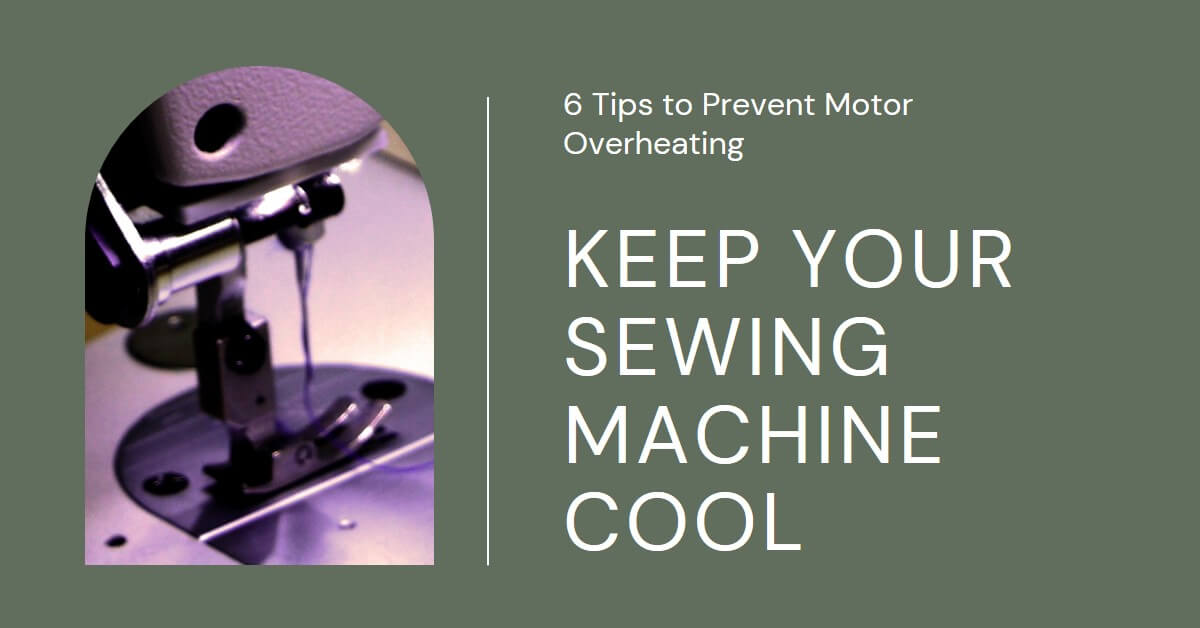Image: “Article Feature Image” by Bing is licensed under [CC BY-NC-SA 4.0]. Source: Bing Graphic Art.
Sewing machines are essential tools for crafters and professionals alike, but their motors can sometimes overheat, leading to performance issues and potential damage.
Protecting your sewing machine motor from overheating is crucial for maintaining its longevity and ensuring smooth sewing operations.
To prevent sewing machine motor overheating:
- Use a voltage regulator.
- Ensure proper ventilation and cleanliness.
- Use the machine correctly and avoid excessive speed.
- Perform regular maintenance and lubrication.
- Monitor temperature and address any unusual heat.
Let’s dive into the details;
Understanding Sewing Machine Motor Overheating
A sewing machine motor can overheat due to various reasons, such as prolonged use, inadequate ventilation, or incorrect usage.
Several factors can cause a sewing machine motor to overheat. Here are some common causes:
- Excessive use: Continuous or prolonged use of the sewing machine without giving the motor sufficient rest periods can lead to overheating. The motor may become strained and generate excessive heat as a result.
- Inadequate ventilation: Insufficient airflow around the motor can impede heat dissipation, causing it to overheat. Accumulated dust, lint, or debris in the machine’s vents can also restrict airflow and contribute to motor overheating.
- Incorrect usage: Using the sewing machine at high speeds for extended periods can put excessive strain on the motor and cause it to overheat. Additionally, using the wrong needle size or thread type for the fabric being sewn can create unnecessary friction and heat buildup.
- Lack of maintenance: Insufficient lubrication of the motor and moving parts, worn-out or loose belts, or a buildup of lint and debris can impede the smooth operation of the sewing machine. These issues can lead to increased friction and heat, resulting in motor overheating.
- Electrical problems: Faulty wiring, voltage fluctuations, loose connections, or electrical issues within the sewing machine can cause the motor to overheat. It’s important to ensure that the electrical components of the machine are in good condition and functioning properly.
It’s important to recognize the signs and symptoms of motor overheating, which may include unusual heat emanating from the machine, burning smells, or a decrease in sewing speed or power.
Fro more in-depth information on how voltage affects a sewing machine motor read my article: The Silent Threat: How Overvoltage Can Damage Your Sewing Machine Motor
Tips to Protect Your Sewing Machine Motor from Overheating
Using a voltage regulator
Using a voltage regulator can indeed help prevent overheating of the sewing machine motor. Voltage fluctuations or inconsistent power supply can put additional stress on the motor, potentially leading to overheating.
A voltage regulator is designed to stabilize and maintain a consistent voltage level, ensuring that the sewing machine receives the correct and steady power supply it requires.
By using a voltage regulator, you can protect the motor from the harmful effects of voltage spikes or drops, which can occur due to fluctuations in the electrical grid or inadequate wiring.
By maintaining a stable voltage, the motor operates efficiently without excessive heat buildup. This can help extend the lifespan of the motor and prevent overheating issues.
When using a voltage regulator, make sure to select a model suitable for your sewing machine’s power requirements and follow the manufacturer’s instructions for installation and usage.
Read also my article: Unveiling The Causes Of Sewing Machine Motor Burnout.
Maintaining Proper Machine Ventilation
To prevent motor overheating, it’s essential to maintain proper ventilation for your sewing machine.
Regularly cleaning the machine vents and ensuring the workspace is well-ventilated can help dissipate heat effectively.
By removing dust, lint, and debris, you allow air to circulate freely around the motor, reducing the risk of overheating.
Using the Machine Correctly
Using your sewing machine correctly is another crucial aspect of preventing motor overheating.
Avoid running the machine at excessive speeds for extended periods, as it can strain the motor and generate excessive heat.
Additionally, ensure you use the appropriate needle size and thread type for the fabric you’re working with.
Using the wrong combination can create unnecessary friction and heat buildup.
Regular Machine Maintenance
Proper maintenance is key to keeping your sewing machine motor in optimal condition. Regularly lubricating the motor and moving parts according to the manufacturer’s guidelines helps reduce friction and heat.
Checking and replacing worn-out belts is also important, as loose or damaged belts can strain the motor and cause overheating.
Additionally, cleaning the machine regularly and removing lint and debris helps maintain efficient operation and prevents overheating.
Monitoring Machine Temperature
Keeping an eye on your machine’s temperature can help you detect and prevent motor overheating.
Using an external temperature gauge specifically designed for sewing machines can provide accurate readings.
If you notice unusually high heat or detect strange smells coming from the machine, it’s essential to investigate and address the issue promptly to prevent motor damage.
Taking Breaks During Extended Sewing Sessions
If you find yourself engaged in lengthy sewing sessions, it’s crucial to give your sewing machine motor periodic breaks to cool down.
Continuous use without pauses can generate excessive heat and strain the motor. Allowing the motor to rest and cool off not only prevents overheating but also prolongs its lifespan.
Troubleshooting Motor Overheating Issues
Despite taking preventive measures, motor overheating issues may still arise. It’s important to be familiar with common problems that can lead to motor overheating and how to address them.
Consulting your sewing machine’s user manual or seeking professional assistance can help diagnose and resolve specific issues.
Conclusion
Protecting your sewing machine motor from overheating is vital for maintaining its performance and longevity.
By implementing the tips mentioned, such as maintaining proper ventilation, using the machine correctly, performing regular maintenance, monitoring the temperature, and taking breaks during extended sewing sessions, you can ensure your sewing machine runs smoothly and efficiently for years to come.
Remember, a well-cared-for sewing machine will not only enhance your sewing experience but also protect your investment in the long run.
you work With Electricity! Don’t leave empty-handed!
Looking to stay ahead of the game in the world of electrical engineering? Subscribe to my YouTube channel and gain access to exclusive content you won’t find anywhere else!
The staff I recommend (Amazon Affiliate Links to products I believe are high quality):
- Economy 120 Volt/60Hz AC Power Source – Step-Down Voltage & Frequency Converters 1800W
- UNI-T Digital Multimeter Tester UT139C
- 50-Amp Extension Cord for RV “100ft”
- Voltage Stabilizer 110/220v
- Hair Dryer “best selling“
- TOSHIBA EM131A5C-BS Countertop Microwave Ovens
Disclaimer: This contains affiliate links to Amazon products. I may earn a commission for purchases made through these links.



